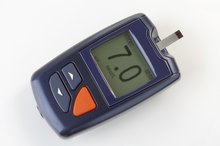Xylitol Nutrition Information
Xylitol is one of the latest sugar substitutes that looks and tastes like sugar but has fewer calories. Although it doesn’t contain many additional nutritional benefits over sugar, it does have potential health benefits that sugar lacks and is used not only in foods, but also in oral hygiene products, cosmetics and medicines.
Identification
Xylitol is a five-carbon sugar alcohol that naturally occurs in the fibers of certain fruits and vegetables such as raspberries, strawberries, yellow plums, lettuce, cauliflower and corn. For commercial purposes, it’s most often extracted from the bark of birch trees. It was first discovered in 1891 by a German chemist and used as a sweetener in Finland due to sugar shortages during World War II. In 1963 it was approved as a food additive by the U.S. Food and Drug Administration, but it wasn’t until recently that it’s been used in a wide variety of food products. It is now available in 35 countries.
Nutrition
Sorbitol Vs. Mannitol
Learn More
One teaspoon of xylitol has 10 calories, compared to sugar, which has 15 calories. However, the sugar alcohols in xylitol don’t have much impact on your blood sugar levels -- one reason it’s considered safe for diabetics. Classified as a carbohydrate, 1 teaspoon of xylitol contains 4 grams of carbohydrates and 4 grams of sugar alcohols. It contains only trace amounts of vitamins and minerals, but it aids in the absorption of calcium and B vitamins in your body. Xylitol supplies amounts of liver glycogen, with about 10 percent of xylitol metabolized in the kidneys and the remainder used up by blood cells, the adrenal cortex, lung, testes, brain and other tissues.
Potential
Xylitol shows promise for treating several medical conditions, including fighting tooth decay, which is one reason it’s found in many toothpaste and chewing gum products. In other studies, Drugs.com reports that xylitol has demonstrated the ability to treat middle ear infections, inhibit the growth of streptococcus pneumoniae bacteria and helped prevent osteoporosis by accelerating bone repair and improving the bioavailability of calcium salts in calcium-deficient rats. Xylitol is also frequently combined with amino acids and other carbohydrates in intravenous nutrition supplements.
Considerations
Xylitol Sweetener Side Effects
Learn More
Like other sugar alcohols, xylitol can cause diarrhea at high doses. Reports have indicated other symptoms such as nausea, bloating, gas, and colic with doses exceeding 40 to 50 grams a day. In extremely high dosages, such as those sometimes given in intravenous solutions, it may contribute to kidney failure.
Warning
Like other foods such as chocolate, xylitol may be safe for humans but isn’t safe for dogs, according to the Animal Poison Control Center of the American Society for the Prevention of Cruelty to Animals. As few as two or three sticks of xylitol gum could be toxic to a 20-pound dog. Within 30 minutes of consuming a small amount, dogs may experience a severe drop in blood sugar, vomiting, lethargy and seizures.
Related Articles
References
Writer Bio
Bonnie Singleton has been writing professionally since 1996. She has written for various newspapers and magazines including "The Washington Times" and "Woman's World." She also wrote for the BBC-TV news magazine "From Washington" and worked for Discovery Channel online for more than a decade. Singleton holds a master's degree in musicology from Florida State University and is a member of the American Independent Writers.









